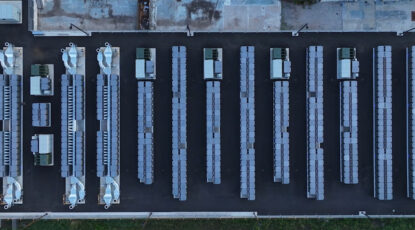The race to reduce greenhouse gas emissions is the defining challenge of our generation. As the worldwide goal of limiting temperature increases grows nearer, industries, policymakers, and innovators increasingly seek to find solutions to the mounting pressures of climate change. One solution rising to the top is carbon capture technology.
What’s Carbon Capture Technology?
Carbon capture technology (CCT) is a method of capturing and storing carbon dioxide (CO2) emissions from industrial processes, thereby preventing them from being released into the environment. This revolutionary technology is being touted for its potential to help the world reduce carbon emissions and reach its climate action goal of net-zero carbon emissions by 2050.
In particular, climate experts note its potential for targeting large emissions sources, such as power plants, cement factories, and chemical production facilities, which are some of the largest contributors to global carbon emissions.
The CCT process generally involves three main steps:
- Capture: CO2 is captured directly from the emission source. This can be achieved through various techniques, including pre-combustion capture (where CO2 is separated from other gasses before combustion), post-combustion capture (capturing CO2 after the fuel has been burned), and oxy-fuel combustion (where fuel is burned in pure oxygen to produce a concentrated CO2 stream).
- Transport: Once captured, the CO2 is compressed into a liquid form and transported via pipelines, ships, or other means to a designated storage site.
- Storage: The captured CO2 is then stored in underground geological formations, such as depleted oil and gas fields or deep saline aquifers, where it can be safely contained for thousands of years. In some cases, CO2 is also used for enhanced oil recovery (EOR), where it is injected into oil fields to help extract more oil, but this is viewed as a temporary solution while carbon-neutral storage methods are developed.
Carbon Capture Technology Aids Climate Action in Several Ways
Carbon capture, usage, and storage (CCUS) can play a strategic role in global decarbonization efforts through several means. These include:
- reducing emissions in ‘hard-to-abate’ industries (such as power plants and others referenced previously)
- producing low-carbon electricity and hydrogen, which reduces carbon emissions while also supplying hydrogen, a cleaner form of energy
- removing existing CO2from the atmosphere
This capability, in particular, is expected to be instrumental in reaching net zero emissions globally. In fact, a 2022 report from the Intergovernmental Panel on Climate Change (IPCC), the United Nations body for assessing the science related to climate change, carbon dioxide removal (CDR) was featured more prominently than ever before as part of a comprehensive strategy for reducing greenhouse gas emissions. Many experts see CDR technologies as a critical complement to a variety of carbon mitigation strategies.
Advanced Carbon Capture Technology and Solid Oxide Fuel Cells
As mentioned, carbon capture and storage is typically achieved in one of three ways: post-combustion, pre-combustion, and oxy-fuel combustion. While workable, the problem hindering their expansion is that most of these carbon capture technologies use so much power that they offset many of their environmental benefits.
Bloom Energy has been recognized as a prominent leader in the clean energy sector, with innovations dating back to our CEO’s work with NASA. One of our most notable achievements has been the development of the Bloom Energy Server®, with solid oxide fuel cells (SOFCs), which use an electrochemical process to generate clean, reliable, and highly efficient power while significantly reducing carbon emissions.
This breakthrough technology improves energy resilience and reduces carbon output, effectively setting new standards for sustainability, especially in the AI data center space. In addition, Bloom’s approach not only removes carbon but also converts it into new sources of high-quality carbon for potential use in a variety of industries. Furthermore, the solid oxide fuel cell platform can be harnessed to produce and utilize hydrogen, which is recognized as the renewable fuel of the future. Many companies across several industries are now using Bloom’s SOFC technology to power their data centers and other mission-critical facilities.
The Future Outlook for Carbon Capture Technology
While carbon capture technology has been in development for decades, its deployment has remained limited due to high costs and a lack of policy support. However, this is changing. New innovations – such as Bloom Energy’s solid oxide fuel cells coupled with strategic partnerships such as with Chart Industries – are making carbon capture more efficient and affordable. Also, increasing investment in research and development, combined with favorable government policies such as tax credits and carbon pricing, are accelerating the deployment of CCT at scale. According to the International Energy Agency (IEA), carbon capture must account for nearly 15% of the emissions reductions required to meet net-zero targets by 2050.
As such, carbon capture technology has become an indispensable part of the solution to achieving net-zero emissions. It addresses the challenge of decarbonizing hard-to-abate sectors, complements renewable energy, and even offers the potential to remove historical CO2 from the atmosphere. It’s definitely one to watch as the world’s quest for carbon reduction escalates in the coming decades.
Bloom Takes a Leading Role in Carbon Capture Offerings
Bloom is an innovator and champion of clean energy and is helping to make cutting-edge technologies like carbon capture more broadly available. In fact, a prime example of Bloom’s pivotal role in advancing carbon capture use is clearly demonstrated in a February 13, 2025 announcement regarding a groundbreaking partnership with Chart Industries, Inc. (NYSE: GTLS), a global leader in energy and industrial gas solutions. The partnership will combine Chart’s carbon capture know-how with Bloom’s high-purity carbon dioxide (CO2) exhaust stream to generate near zero-carbon, always-on power. The result will be a cost-effective solution for customers, like data centers and manufacturers, who are seeking power solutions that can be deployed rapidly without compromising reliability or emission goals.
To learn more about Bloom Energy’s advanced carbon capture technology, please visit our website.
Carbon Capture FAQs
- What Is Carbon Capture?
Carbon capture technology (CCT) is a method of capturing and storing carbon dioxide (CO2) emissions from industrial processes, thereby preventing them from being released into the environment. According to experts, carbon capture, usage, and storage (CCUS) can play a strategic role in global decarbonization efforts. The International Energy Agency (IEA) notes that carbon capture must account for nearly 15% of the emissions reductions required to meet net-zero targets by 2050. - How Does Carbon Capture Aid the World’s Climate Action Goals?
Carbon capture can play a strategic role in global decarbonization efforts through several means. These include reducing emissions in ‘hard-to-abate’ industries (such as power plants, cement factories, and chemical production facilities); producing low-carbon electricity and hydrogen, which reduces carbon emissions while also supplying hydrogen, a cleaner form of energy, and removing existing CO2 from the atmosphere. - What is the Future Outlook for Carbon Capture Technology?
Until recently, carbon capture’s deployment has remained limited due to high costs and a lack of policy support. However, this is changing. New innovations – such as Bloom Energy’s solid oxide fuel cells coupled with strategic parctnerships (such as with Chart Industries) – are making carbon capture more efficient and affordable. Also, increasing investment in research and development, combined with favorable government policies such as tax credits and carbon pricing, are accelerating the deployment of CCT at scale.



